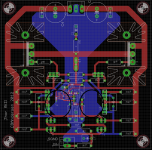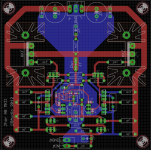I'm not home before tomorrow, but got my hand on a power cable with ground that fits my laptop charger. Like I predicted, now with both my headamp and laptop grounded the hum is GONE. Only thing left when turning the volume knob past 12 o'clock is a very faint high frequency noise, most likely coming from my laptop. If I were to put a DAC between my laptop and my headamp that very faint high frequency noise would most likely also go away.
Always a good day when a problem gets taken care of.
Always a good day when a problem gets taken care of.
Last edited:
Possible addition to Thor No Thump Board MKII :
Thinking about switching from the 12VDC relay used and going with the 9VDC version of the relay instead. If I then add a LM7809 to the board as well, one can now supply the No Thump Board MKII with anything from 12-18VDC Volt without killing the relay coil. This makes it alot easier to configure the amp supply for voltages higher than +/-12VDC since the No Thump Board now has its own 9VDC regulator.
This gives a supported supply range of +/- 12 to 18VDC, which gives between 7 and 11 Vrms output voltage.
Thinking about switching from the 12VDC relay used and going with the 9VDC version of the relay instead. If I then add a LM7809 to the board as well, one can now supply the No Thump Board MKII with anything from 12-18VDC Volt without killing the relay coil. This makes it alot easier to configure the amp supply for voltages higher than +/-12VDC since the No Thump Board now has its own 9VDC regulator.
This gives a supported supply range of +/- 12 to 18VDC, which gives between 7 and 11 Vrms output voltage.
Last edited:
To avoid any confusion, with various board versions and combinations of those, I'm only selling the complete V1 sets I have before I switch to MKII verisons of all boards. This means I have 2 or 3 complete sets of V1 boards. After that, it will take 1 to 1.5 months before I have MKII verisons of all boards built and tested.
So there will be no sets combining V1 with MKII boards.
So there will be no sets combining V1 with MKII boards.
To turn this into a power house for these ortho headphones:
I am looking at reducing the NFB R1=3k R17=800 for more gain. Change the opamp to op2604, the rails to 24V, and up (double) the bias on the output mofset. It simulates good and can deliver the 2W hifiman calls for into their 38 ohm models. Of course off board heatsinks required.
Either that or order another set of boards for balanced, but I haven't found a balanced dac I am happy with so looking at the above.
I am looking at reducing the NFB R1=3k R17=800 for more gain. Change the opamp to op2604, the rails to 24V, and up (double) the bias on the output mofset. It simulates good and can deliver the 2W hifiman calls for into their 38 ohm models. Of course off board heatsinks required.
Either that or order another set of boards for balanced, but I haven't found a balanced dac I am happy with so looking at the above.
To turn this into a power house for these ortho headphones:
I am looking at reducing the NFB R1=3k R17=800 for more gain. Change the opamp to op2604, the rails to 24V, and up (double) the bias on the output mofset. It simulates good and can deliver the 2W hifiman calls for into their 38 ohm models. Of course off board heatsinks required.
Either that or order another set of boards for balanced, but I haven't found a balanced dac I am happy with so looking at the above.
Short answer : You're nuts! :
Long answer :
Interesting idea, I understand the increased bias to get higher Class A output into a 38 Ohm load, but I don't quite understand increasing the rails to +/- 24VDC. Even +/- 18VDC is enough for around 10.5 Vrms which equals almost 3W into a 38 Ohm load.
Other than that, remember to use sufficient cooling, it is gonna get HOT, not only the output transistors but also the LM317/337 preregulators in the supply.
MKII versions of all boards are now done.
All issues from the V1 boards has been taken care of and some stuff has been added to the No Thump Board MKII, it now has an onboard LM7809 regulator and uses a 9VDC relay so you can supply the board with anything from 12-35VDC.
Don't know when they will be done. Could order them already next week or the week after that, but might not have something to show(mounted and tested boards) before end of June.
All issues from the V1 boards has been taken care of and some stuff has been added to the No Thump Board MKII, it now has an onboard LM7809 regulator and uses a 9VDC relay so you can supply the board with anything from 12-35VDC.
Don't know when they will be done. Could order them already next week or the week after that, but might not have something to show(mounted and tested boards) before end of June.
Last edited:
Short answer : You're nuts! :
Long answer :
Interesting idea, I understand the increased bias to get higher Class A output into a 38 Ohm load, but I don't quite understand increasing the rails to +/- 24VDC. Even +/- 18VDC is enough for around 10.5 Vrms which equals almost 3W into a 38 Ohm load.
Other than that, remember to use sufficient cooling, it is gonna get HOT, not only the output transistors but also the LM317/337 preregulators in the supply.
Yea, just the simulator showed a good 20 db descrease in distortion with the higher rails (@2w into 38 ohms).
Yea, just the simulator showed a good 20 db descrease in distortion with the higher rails (@2w into 38 ohms).
If that is true, and I have no reason to beleive it isn't, that is a good reason to have higher rails.
Yea, just the simulator showed a good 20 db descrease in distortion with the higher rails (@2w into 38 ohms).
Spice always does this, but in the real world i'm not so sure of a direct correlation. There are other parameters of the output transistors that spice does NOT take into account.
A moderate increase in voltage rails well within SOA, should be good, too much and you can have other issues.
As I'm planning to get a pair of Beyerdynamic DT 880 250 Ohm headphones I have been "optimizing" my design for driving those. It is also a very balanced configuration that will be good enough for anything from 32 to 600 Ohm headphones, except very low sensitivity/current hungry headphones like orthos and similar.
Increase rails to +/- 15VDC, reduce bias to 115mA. This gives a Class A output of 200mW into a 32 Ohm load, 350mW into a 250 Ohm load and about 140mW into a 600 Ohm load. Into a 32 Ohm load you will get about 2.6W Class AB while 250 and 600 Ohm loads will stay in Class A all the way since you are voltage limited. Something to be aware of is that driving a 32 Ohm load into Class AB is not an optimal solution with the matching supply board, it is designed to operate with pure Class A loads. But then again, headphones with "normal" sensitivity and current demands should never need more than 200mW Class A anyway.
Increase rails to +/- 15VDC, reduce bias to 115mA. This gives a Class A output of 200mW into a 32 Ohm load, 350mW into a 250 Ohm load and about 140mW into a 600 Ohm load. Into a 32 Ohm load you will get about 2.6W Class AB while 250 and 600 Ohm loads will stay in Class A all the way since you are voltage limited. Something to be aware of is that driving a 32 Ohm load into Class AB is not an optimal solution with the matching supply board, it is designed to operate with pure Class A loads. But then again, headphones with "normal" sensitivity and current demands should never need more than 200mW Class A anyway.
This is my ortho version. I changed the input jfets to sk170bl/2sj74bl just because we can buy matched quads from AMB labs to save time. The gain is increased.
Simulation shows a 8.5Vp with a 2.1Vrms input into a 38 ohm load with 2H -115db down, which should be plenty power for hifiman HE5-LE, HE-500, and LCD-2 orthos.

Simulation shows a 8.5Vp with a 2.1Vrms input into a 38 ohm load with 2H -115db down, which should be plenty power for hifiman HE5-LE, HE-500, and LCD-2 orthos.

This is my ortho version. I changed the input jfets to sk170bl/2sj74bl just because we can buy matched quads from AMB labs to save time. The gain is increased.
Simulation shows a 8.5Vp with a 2.1Vrms input into a 38 ohm load with 2H -115db down, which should be plenty power for hifiman HE5-LE, HE-500, and LCD-2 orthos.

Not bad, not bad at all. Only reason I didn't use the SK170/SJ74 combo is because of price and the EOL'ing of the SJ74 JFET several years ago.
Are you using 10 or 16pF compensation caps? Thats seems a little low, simulation works great with just 10pF but in the real world I had to change it to 39pF to get it stable with my Sennheiser HD415 headphones. However, it might work, the first 2 test headphones I used for testing worked absolute without a hitch with just 10pF. But then again you have changed almost all of the resistor values and you are running higher gain, higher gain setting in it self does improve stability somewhat. The closer you get to unity gain the more compensation you most likely need.
8.5Vp is about 960mW into a 38 Ohm load and it should be plenty, but weren't you going for a lot higher than that?
Last edited:
The amp could be configured to be a high impedance(250-600 Ohm) driving monster. Use an OPA445(+/-45 Volt max, +/-5mV offset max) for DC servo, increase rails to +/- 30VDC, bias output FET's to about 70mA.
That is something like 1600mW into 250 Ohm and 670mW into 600 Ohm with vanishingly low distortion.
That should be more than enough power for any 250 Ohm or 600 Ohm headphone on the market.
That is something like 1600mW into 250 Ohm and 670mW into 600 Ohm with vanishingly low distortion.
That should be more than enough power for any 250 Ohm or 600 Ohm headphone on the market.
The amp could be configured to be a high impedance(250-600 Ohm) driving monster. Use an OPA445(+/-45 Volt max, +/-5mV offset max) for DC servo, increase rails to +/- 30VDC, bias output FET's to about 70mA.
That is something like 1600mW into 250 Ohm and 670mW into 600 Ohm with vanishingly low distortion.
That should be more than enough power for any 250 Ohm or 600 Ohm headphone on the market.
I have a pair of those 600 ohm akg sextetts that need 10+Vrms, thanks for the tip about the opamp.
The new orthos are a real challenge though, the best is considered the HE-6, said to need 6 watts into 50 ohms. Thats 25 Vp, 350 mA. To put into perspective a 40 watt speaker amp swings 25Vp at full power.
I'm sticking with the HE5-LE orthos which seem to perform well with 1W ~8Vp (they sound amazing), but it raises the question with the popularity of orthos your Thor is really the only DIY headphone design that has the foundation to power these things.
I am a SET tube person, but it is just about unrealistic to build an SET that can swing 16Vp-p into 38 ohms without gobs of distortion and poor damping. Will probably use a tube preamp ahead of the thor (keep the thor gain at 2 and use it as a semi buffer.) The no NFB mofset buffer designs that are out there (F4, Tumos, etc) seem to add way to much distortion at these high voltage swings .
Do you think this would be unity gain stable? I am a tube guy and most of the high power mofset buffer designs I'm looking at are pretty high distortion because the designs have no NFB. Would be nice to have a low distortion high power buffer after a tube gain stage in the arsenal.
Do you think this would be unity gain stable? I am a tube guy and most of the high power mofset buffer designs I'm looking at are pretty high distortion because the designs have no NFB. Would be nice to have a low distortion high power buffer after a tube gain stage in the arsenal.
I would not go lower than X2 gain, stability would most likely be a serious issue at unity gain, unless you increase the compensation caps considerably.
Suimulation shows stability at unity gain driving a 32 Ohm load parallel with 500nF. This is with 150pF compensation caps.
However, real world testing might still show stability issue. I thought 10pF compensation was good enough for stability at X2 gain, but it turned out I needed 39pF.
It might work at unity gain.
To make it easier to use higher voltages for the Thor MKII amp boards I am adding a pair of 78L15/79L15 regulators for the DC servo. This should make it a lot easier to use anything from +/- 12VDC to +/- 30VDC for the Thor MKII amp boards without having to use less precise and expensive opamps like OPA445 and similar for the DC Servo
Attached picture shows the likely placement of the regulators.
Attached picture shows the likely placement of the regulators.
Attachments
...78L15/79L15 regulators....
That should have been 78L09/79L09 regulators. Otherwise using a +/- 12VDC supply for the amp boards wouldn't be possible.
- Status
- This old topic is closed. If you want to reopen this topic, contact a moderator using the "Report Post" button.
- Home
- Amplifiers
- Headphone Systems
- Thor, an all discrete Lateral FET Headphone Amplifier.

